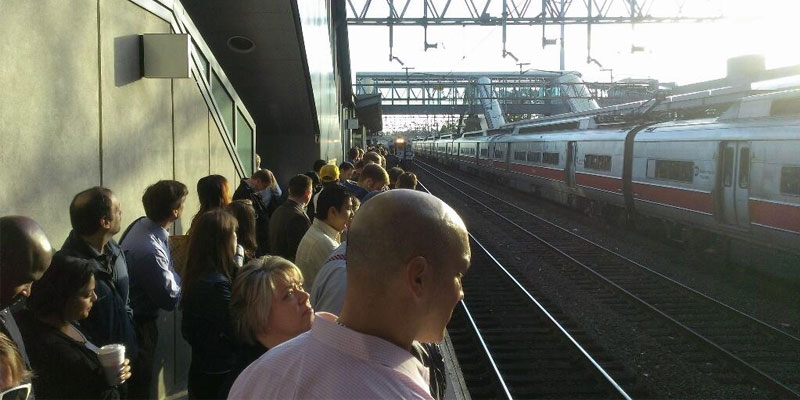 Passengers await an “extra” Metro-North train as it pulls up to a crowded platform in Stamford this morning.
Passengers await an “extra” Metro-North train as it pulls up to a crowded platform in Stamford this morning.
Wednesday morning, Metro-North had its latest problem strike when a feeder line powering a portion of the lower New Haven Line fail, eliminating all electric service into Grand Central Terminal. The resulting changes that have followed have been limited, challenging and at times frustrating. Yet it also shows an agency that manages to work through yet another emergency with some pretty skillful and creative strategies.
Metro-North’s year has been tough, to say the least. A year ago, it faced the damage caused by Hurricane Sandy, and has since dealt with heavy snow, a train derailment on the Hudson line and a train collision and derailment on the New Haven Line. This week’s feeder incident is similar to the collision and derailment in that the redundancies normally in place weren’t available due to scheduled service.
As I noted in a comment on Second Avenue Sagas, and site owner Ben Kabak echoed, there’s only so much redundancy you can justify building; the question is whether these ongoing issues are a result of the age of the infrastructure. The feeder line left active while the other one was repaired was 36 years old; they normally have a 30-year lifespan. (Frankly, it sounds like the trains and how they were pushed longer than planned.) However, ConEd and Metro-North say they did load testing before the plan to upgrade one of the two lines was implemented. They say they think the line got overloaded and overheated, but can’t confirm until they cool it with nitrogen, which is almost like half-confirmation of the overheating part of it at any rate.
So, how is Metro-North doing? Wednesday morning, as tweets were going out saying that service was suspended, I stood on the platform at Stamford. One train was listed as coming in, and was running really late. A diesel pulled up momentarily and I largely got to work on time. Even before their initial plan was in place, Metro-North had already resumed used of the diesels to get people moving, and was retrieving the stalled trains stuck because of the outage. I sat out Wednesday night and stayed in the city, because I’ve learned Metro-North’s plans, while usually pretty solid, require a day to settle in.
Last night, I caught the 9:10 train, which was scheduled as a local. The train wasn’t overcrowded, but it was disappointing that a normally 44-minute commute was now 80, partly because it was local and partly I assume because the diesels need the extra time. I got home much later than I normally would, but at least I was home.
This morning, I gave myself some extra time and got to Stamford to see the previous train’s doors closed and people on the platform who didn’t get on. A guy with a phone was instructing the station master to announce the next train, as well as a second “extra train” would be arriving soon. This shows some of the subtlety and cleverness of their planning. Metro-North had an extra train or two in position for crowd control. The Stamford platform quickly filled up after the previous train had left, but the extra train pulled in, empty, and took care of the problem.
This also doesn’t reflect the second option: Take a train to Rye, bus over to White Plains and head into the city on the Harlem Line. A couple thousand people did that yesterday.
It’s easy to get angry and blame Metro-North for bad service, but arguably, the agency has done an incredible job of achieving the closest thing to normalcy it can when these situations happen. Because I take the train out of Stamford, I certainly have a less frustrating time than people farther up the line, where another transfer and wait follows to continue on their way to points further east. But overall, Metro-North at least deserves a bit of credit for its efforts there. Of course, the bigger questions about infrastructure need to be addressed, particularly why it’ll potentially be weeks before this is resolved. But for now, I’ll make do.